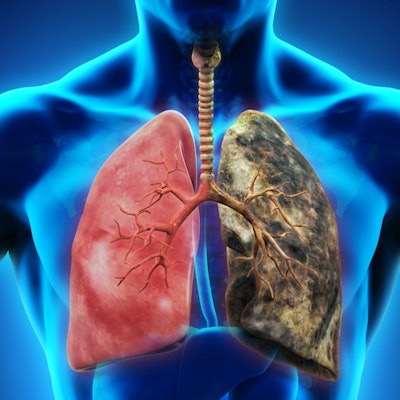
The latest results from the Multicentric Italian Lung Detection (MILD) trial highlighted the increasing benefits of CT lung screening over time -- starting after year five -- culminating in a 39% reduction in lung cancer mortality risk for eligible smokers at 10 years, according to a recent study published in the Annals of Oncology.
For the MILD trial, researchers from the Istituto di Ricovero e Cura a Carattere Scientifico (IRCCS) National Cancer Institute of Milan prospectively evaluated the potential advantages of annual or biennial CT lung cancer screening in 4,099 eligible smokers between 2005 and 2018.
Their 10-year results showed that CT lung screening was associated with a 39% lower risk of lung cancer mortality, compared with no screening -- exceeding the 20% reduction reported in the National Lung Screening Trial (NLST) and the 26% reduction in men from the Dutch-Belgian Randomized Lung Cancer Screening (NELSON) trial (Ann Oncol, April 1, 2019).
"The MILD trial provides additional evidence that prolonged intervention beyond five years can enhance the benefit of screening," first author Dr. Ugo Pastorino and colleagues wrote. "The incremental effect of prolonged [CT lung] screening achieved a significant mortality reduction at 10 years, notwithstanding biennial rounds and active surveillance."
Longer screening, better results
In 2011, the NLST researchers reported substantial reductions in lung cancer mortality risk from a baseline CT lung screening exam followed by two annual screening exams, at which point they concluded the study. The early termination of this flagship trial prompted other groups to conduct similar randomized controlled lung screening trials but with a longer period for follow-up screening.
Perhaps the most prominent of such cases was the NELSON trial, which extended the duration of screening to 5.5 years after the initial exam. The investigators discovered that this long-term screening resulted in an even greater reduction in lung cancer mortality risk than observed in the NLST.
In a similar effort, Pastorino and colleagues launched the MILD trial to explore the efficacy of long-term CT lung screening for eligible smokers or former smokers who were at risk of, but not yet diagnosed with, lung cancer. The researchers prospectively assessed the outcomes of 4,099 individuals between the ages of 49 and 75 with a smoking history of at least 20 pack-years. They also implemented active surveillance of subsolid lesions with PET to minimize the need for unnecessary surgeries. All of the participants either underwent annual or biennial CT lung screening exams or did not receive an imaging-based lung screening exam.
The five-year results of the MILD trial, published in 2012, indicated no statistically significant difference in lung cancer mortality risk between the screening and non-screening groups, contrary to the outcomes of the NLST and NELSON trials.
After expanding the length of the trial to 10 years for the current study, however, the researchers found that continuing CT lung screening beyond the first five years ultimately led to reductions in lung cancer mortality risk that were even greater than those noted in the other large-scale trials.
CT lung screening prevails
Pastorino and colleagues found that the CT lung screening cohort had a 39% lower risk of lung cancer mortality and a 20% lower risk of mortality from all causes, compared with the control group, within the first 10 years since the time of the initial exam.
They also found that the CT lung screening group had more than double the percentage of stage I lung cancers diagnosed than did the control group, as well as considerably fewer missed lung cancers and benign tumor resections.
| CT lung cancer screening vs. no screening in the MILD trial | ||
| No screening | CT lung screening | |
| Overall mortality at 10 years | 6.5% | 5.8% |
| Lung cancer mortality risk at 10 years* | 2.5% | 1.7% |
| Stage I lung cancer diagnosis* | 21.7% | 50% |
The benefit of CT lung screening was particularly pronounced after the fifth year of screening, rising to a 58% reduced risk of lung cancer mortality (p = 0.004) and a 32% reduction in overall mortality (p = 0.01), compared with no screening.
"Indeed, it appears reasonable that 10-year results of MILD were empowered by the continuous contribution of prolonged [CT lung] screening, which reversed the earlier negative five-year figures," the authors wrote.
Further analyses also indicated that the specificity and sensitivity of lung cancer detection in the first three rounds of annual and biennial screening for the study were higher than those reported in the other screening trials. This suggests that CT lung cancer screening using a biennial screening regimen could be an effective strategy for curtailing radiation exposure, the authors noted.
"MILD results at 10 years provide indirect evidence that tailored biennial [CT lung screening] did not compromise the efficacy of prolonged screening duration, but this issue will require future confirmation by a multicentric randomized trial with adequate sample size," they wrote.




















